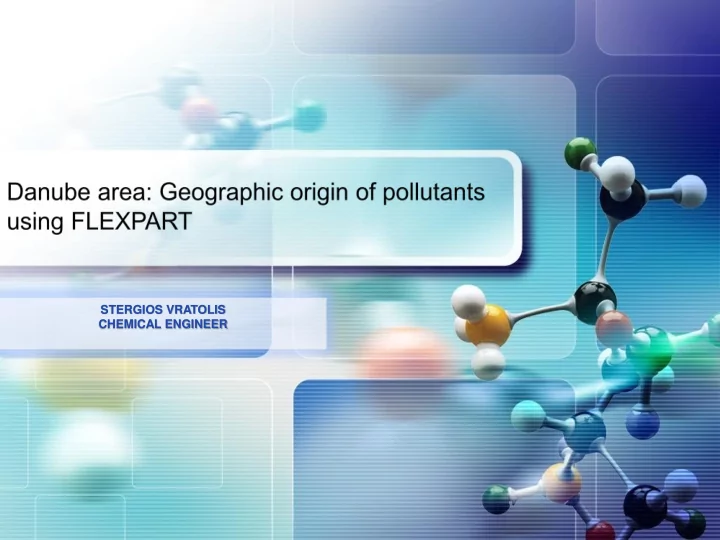

STERGIOS VRATOLIS CHEMICAL ENGINEER
What is FLEXPART? Lagrangian particle dispersion model (LPDM) • Particles released with a certain amount of mass – species • Mean wind and turbulence move particles • Particles follow the eddies and are not deformed • Many particles are needed to properly represent a plume Delia Arnold ATM/FLEXPART NUIG 2015 Training
How does it work? Delia Arnold ATM/FLEXPART NUIG 2015 Training
NCSR “DEMOKRITOS” Athens Footprint Examples ENVIRONMENTAL RADIOACTIVITY LABORATORY Athens ln(t) ln(t) Footprint 2014-06-01 at 500 m agl, Air tracer Footprint 2014-06-12 at 500 m agl, Air tracer
NCSR “DEMOKRITOS” PSCF Description ENVIRONMENTAL RADIOACTIVITY LABORATORY Natural logarithm of residence time in cells • 5-day backward simulation by FLEXPART for PMF Budapest dataset ( n ij ). model at hourly intervals (Draxler and Rolph, 2003) • Air parcels (particles) below 3000 m included • PSCF ij =m ij /n ij • m ij =residence time in a cell that has equivalent concentration >90th percentile of the mean concentration observed Natural logarithm of residence time in cells for • n ij =residence time in a cell Nitrate Rich source above the 90 th percentile ( m ij ). A Binomial distribution is applied in order to distinguish the cells with very low residence time
NCSR “DEMOKRITOS” Input data for analysis ENVIRONMENTAL RADIOACTIVITY LABORATORY • Positive Matrix Factorization has been employed (Model EPA PMF5.0). • The most relevant source with respect to long-range transport is secondary aerosol, while sea salt, heavy oil combustion and soil dust (during African dust events) may be also associated with long-distance sources. • Biomass Burning and Traffic are considered mainly local. • Sources with similar profiles could be distinguished if we know whether they are transported or not. Air mass origin provides us with additional information.
PSCF: Source regions for Secondary NCSR “DEMOKRITOS” Aerosol up to 3000 m and Emission regions ENVIRONMENTAL RADIOACTIVITY for SO 2 LABORATORY Budapest-PM2.5 Natural logarithm of SO 2 Emissions (kt/year) for 2015 from ECLIPSE DATABASE Budapest Secondary aerosol PSCF (http://eclipse.nilu.no/, forecast). Analysis – 5 days backward run – up Anthropogenic sources are included, to 3000 m excluding shipping and aviation.
PSCF: Source regions for Nitrate Rich-BB NCSR “DEMOKRITOS” up to 3000 m ENVIRONMENTAL RADIOACTIVITY LABORATORY Budapest-PM2.5 Budapest-PM2.5 Budapest BB PSCF Analysis – 5 Budapest Nitrate rich PSCF Analysis – 5 days backward run – up to 3000 m days backward run – up to 3000 m
PSCF: Source regions for Nitrate Rich-BB NCSR “DEMOKRITOS” up to 3000 m ENVIRONMENTAL RADIOACTIVITY LABORATORY Budapest-PM2.5 Budapest-PM2.5 Budapest air mass origin on the 14 th Agricultural fires on February – of February 2015 – 5 days backward March 2015, MODIS satellite. run – up to 3000 m
Sofia: Source regions for Secondary NCSR “DEMOKRITOS” Sulfate up to 3000 m ENVIRONMENTAL RADIOACTIVITY LABORATORY SOFIA-PM10 SOFIA-PM10 5 day FLEXPART PSCF: Sofia 5 day FLEXPART PSCF: Sofia Fuel- Secondary aerosol PSCF Analysis – Oil PSCF Analysis – 5 days 5 days backward run – up to 3000 m backward run – up to 3000 m
Sofia: Source regions for NCSR “DEMOKRITOS” Resuspension up to 3000 m ENVIRONMENTAL RADIOACTIVITY LABORATORY SOFIA-PM10 Sofia Resuspension PSCF Analysis – The global distribution of TOMS (Total 10 days backward run – up to 3000 m Ozone Mapping Spectrometer) dust sources.
Zagreb: Source regions for Secondary NCSR “DEMOKRITOS” Inorganic ENVIRONMENTAL RADIOACTIVITY LABORATORY Zagreb-PM2.5 Zagreb-PM2.5 Zagreb Secondary Inorganic Zagreb Resuspension PSCF PSCF Analysis – 5 days Analysis – 10 days backward run – backward run – up to 3000 m up to 3000 m
NCSR “DEMOKRITOS” Conclusions ENVIRONMENTAL RADIOACTIVITY LABORATORY • Sofia PM10 Secondary aerosol appears to have a small impact from transported pollution in the mesoscale. There is a path of dust transport from the Caspian Sea and perhaps some shipping influence on the Fuel-Oil source from the Mediterranean Sea and Libya. • Budapest is influenced from the central Balkans, Turkey, Ukraine, Russia and Poland. There is significant impact from agricultural fires in north-eastern Europe. • Zagreb dust aerosol appears to originate from Algeria, Tunisia and Libya. • Zagreb is influenced for sulfates and SO 2 mainly from the central Balkans, Russia, and European part of Turkey. • FLEXPART can establish source – receptor relationships via sensitivity footprint (residence time) in each cell. Areas with high sensitivity can have a great impact on the receptor site. • When we use FLEXPART PSCF combined with PMF analysis results, we can obtain an estimate of the geographic regions that affect our measurement site.
Recommend
More recommend